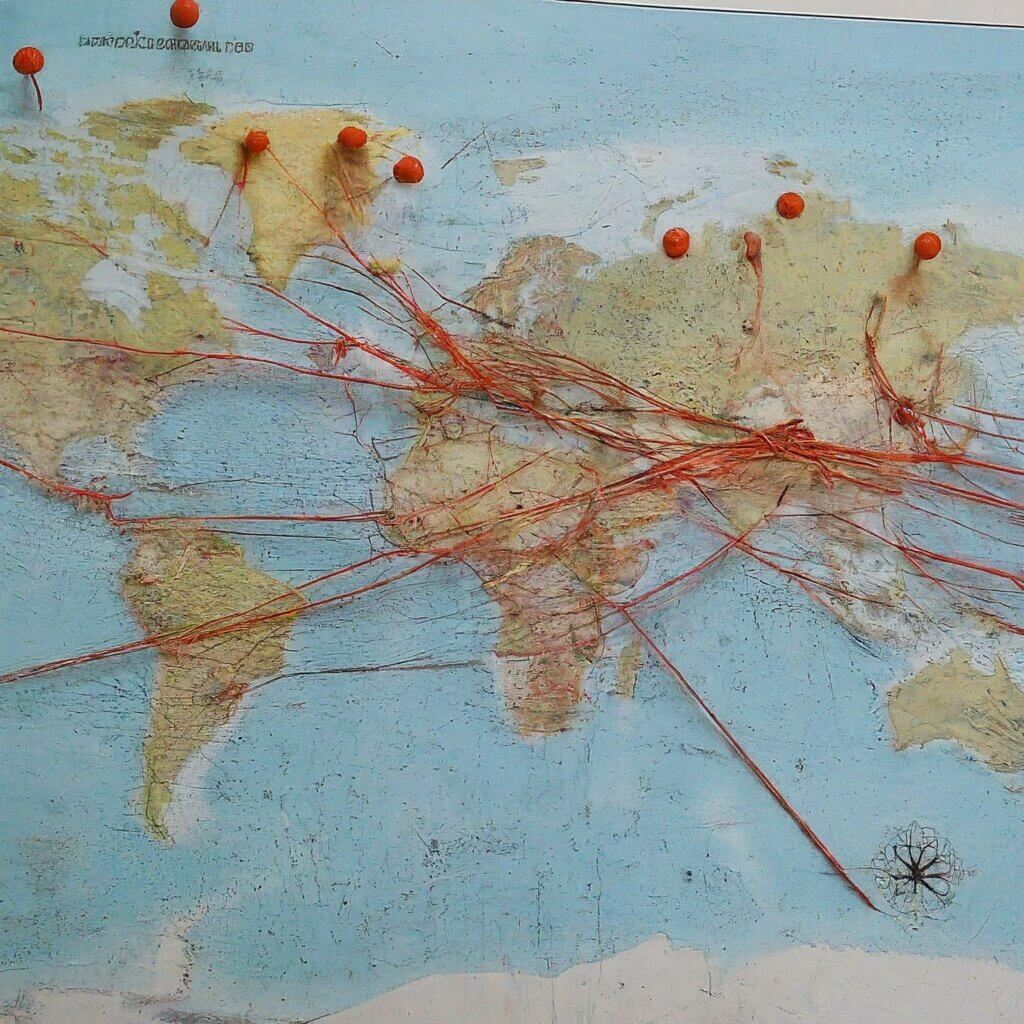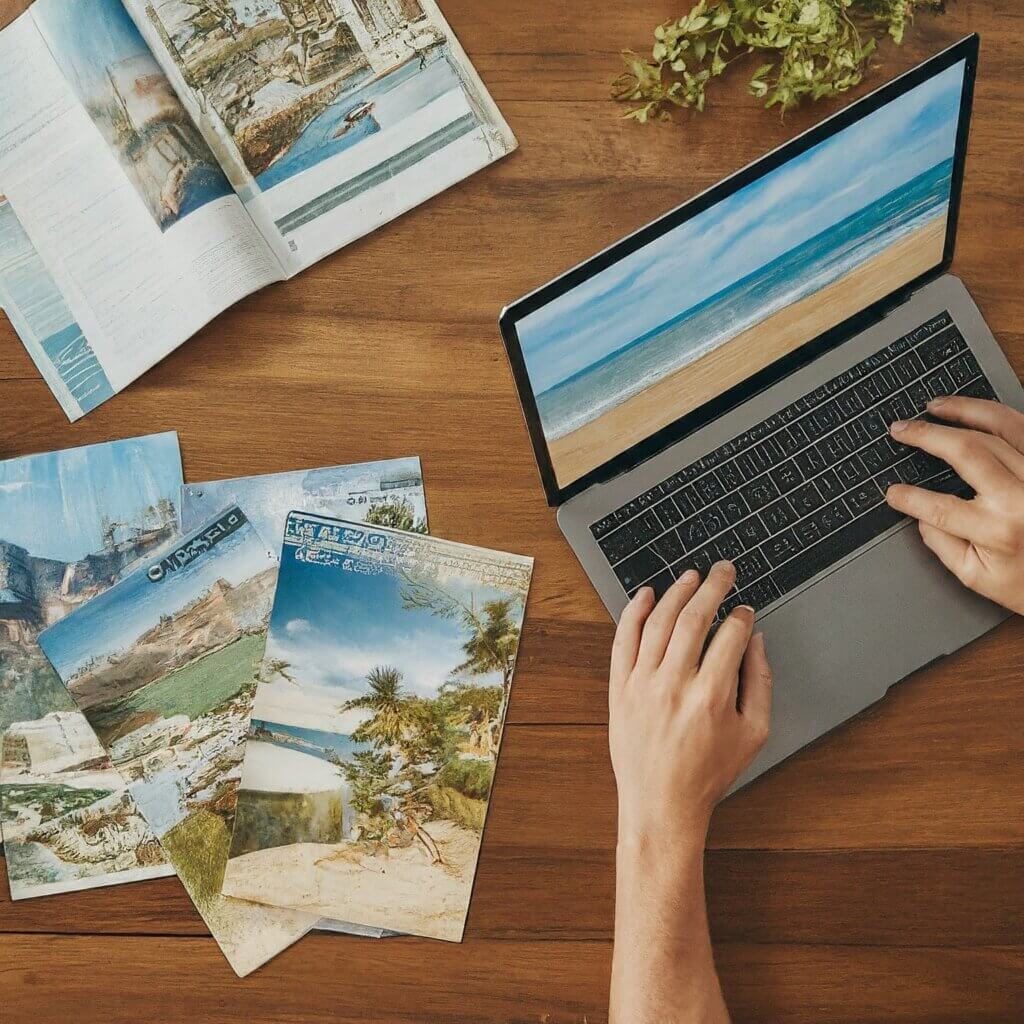
Have you ever dreamt of white-sand beaches, bustling cityscapes, or awe-inspiring natural wonders? The world is brimming with incredible destinations waiting to be explored, and transforming that dream into reality is easier than you think. This comprehensive guide will equip you with all the knowledge and tools you need to plan a trip, from choosing your ideal spot to navigating your chosen destination like a local.
Spark Your Wanderlust: Choosing Your Dream Destination
The first step on your adventure is picking the perfect location! This might seem overwhelming, but with a little introspection and research, you’ll discover your ideal family vacation destination.
- Consider Your Travel Style: Are you a beach bum seeking relaxation (beach vacation ideas), a history buff craving cultural immersion, or an adrenaline junkie on a quest for heart-pounding activities (adventure travel destinations)? Identifying your travel style will help narrow down your options significantly.
- Think About Climate and Seasons: Imagine basking on a sun-drenched Greek island in summer, or exploring the vibrant autumn foliage of New England in fall. Research the weather patterns at your chosen destination throughout the year to ensure a comfortable and enjoyable experience (best time to visit Europe).
- Unleash Your Inner Explorer: Tourist Attractions and Culture: Immerse yourself in ancient ruins, delve into bustling cityscapes, or discover hidden natural wonders. Research the cultural experiences and iconic landmarks your potential destinations offer (unique things to do on vacation).
Budget Plan Like a Pro: Set Financial Limits for Your Trip
Now that you’ve narrowed down your dream location, it’s time to establish a realistic travel budget plan(how to set a travel budget). This financial roadmap will guide your choices for flights, accommodation, and activities throughout your trip. Here are some key aspects to consider:
- Transportation: Compare flight costs, research train or bus options, and factor in potential car rentals if needed. Consider using luxury travel hacking techniques to save on flights or upgrades, allowing you to allocate more funds for experiences or activities during your trip.
- Accommodation: Research hotels, hostels, family vacation rentals, or alternative lodging options that fit your budget plan and travel style (hostels vs hotels for travel).
- Activities: Prioritize your must-do experiences and allocate funds accordingly. Factor in entrance fees, tours, and equipment rentals for planned activities.
- Living Expenses: Estimate daily costs for meals, souvenirs, local transportation, and any unexpected expenses (travel essentials checklist).
Timing is Everything: Picking the Perfect Travel Dates
Choosing the right travel dates can significantly enhance your experience (when is the cheapest time to travel). Here are some factors to consider:
- Weather: Ensure you’re visiting during a comfortable season. Research average temperatures, precipitation patterns, and potential weather events. Avoid peak monsoon season in Southeast Asia or hurricane season in the Caribbean.
- Local Holidays: Public holidays can affect travel costs and attraction closures. Research local holidays in your chosen destination to avoid disruptions.
- Tourist Seasons: Shoulder seasons (spring and fall) often offer the best combination of pleasant weather and manageable crowds (off the beaten path travel destinations).
Mastering the Art of Flight Booking
Once you’ve finalized your dates, it’s time to snag those flight deals! Utilize flight comparison websites like Google Flights, Kayak, or Skyscanner to find the best fares (how to find cheap flights). Here are some pro-tips:
- Be Flexible: Consider flying into a nearby airport or on weekdays for potentially cheaper options.
- Track Prices: Set up price alerts on flight comparison websites to monitor price fluctuations for your desired route.
- Understand Baggage Fees: Be mindful of baggage allowances and factor in potential check-in fees to avoid surprise costs at the airport (cheap flights with checked bags).
Finding Your Home Away From Home: Choosing Accommodation
Your chosen accommodation will be your haven throughout your trip. Consider these factors to find the perfect fit:
- Location, Location, Location: Proximity to desired attractions and public transportation options can significantly impact your travel experience.
- Accommodation Style: Do you prefer the amenities and services of a hotel, the social atmosphere of a hostel, or the space and privacy of a vacations rental? (types of travel accommodation)
- Budget Plan Considerations: Compare prices across different accommodation types to align with your financial limitations.
Craft the Perfect Itinerary: Planning Your Activities
- Strike a Balance: Plan a trip full mix of must-see attractions, unique experiences, and downtime for relaxation. Consider incorporating a free walking tour for a budget-friendly cultural immersion.
- Research Availability: Check online resources for opening hours, ticket prices, and potential booking requirements for specific activities and attractions.
Packing Like a Pro: Conquering Your Travel Checklist
Packing efficiently is key to a stress-free vacation. Here’s how to ensure you have everything you need without overpacking (travel packing tips):
- Research the Climate and Activities: Review weather forecasts and planned activities to determine appropriate clothing. Pack breathable fabrics for hot climates, layers for cooler destinations, and swimwear for beach getaways. Consider quick-drying clothing for easy washing and drying, especially on shorter trips.
- Embrace the Checklist Mentality: Create a comprehensive packing list that includes essentials like comfortable walking shoes, sunglasses, a hat, and a reusable water bottle. Don’t forget toiletries, medications, and travel documents like your passport and visas.
- Utilize Packing Cubes: These space-saving organizers help compartmentalize your belongings and maximize suitcase space.
- The Art of Layering: Packing versatile layers allows you to adapt to fluctuating temperatures and unexpected weather changes.
- The “Just in Case” Mentality: Pack a light rain jacket or a small umbrella for potential downpours. Consider a travel adapter if your destination uses a different electrical system.
- The Power of Multitasking Clothing: Choose versatile clothing items that can be mixed and matched to create multiple outfits. Pack neutral colors that complement each other easily.
- Footwear for Every Adventure: Pack comfortable walking shoes for exploring, sandals for hot weather, and any specific footwear required for planned activities like hiking boots.
- The Entertainment Essentials: Don’t forget a good book, downloaded movies or music, or a travel journal to keep you entertained during downtime.
Navigating Like a Local: Mastering Local Transportation
Getting around your chosen destination is an essential part of your travel experience. Here’s how to navigate with confidence:
- Public Transportation Powerhouse: Research public transportation options like buses, trains, or subways. Purchase travel passes for cost-effective and efficient travel throughout your stay.
- Renting for Freedom: Consider renting a car if your destination offers more freedom with a vehicle. Research rental car options, insurance coverage, and potential one-way rental fees if needed.
- Taxis and Ridesharing: Ridesharing apps like Uber or Lyft can be convenient options for shorter trips, especially in unfamiliar cities. Be mindful of potential surge pricing during peak hours.

Planning for the Unexpected: Preparing for Emergencies
Being prepared for unforeseen situations is crucial for a worry-free trip:
- Travel Insurance: Consider purchasing travel insurance to safeguard yourself against trip cancellations, medical emergencies, or lost luggage.
- Medical Preparedness: Pack any necessary medications and research healthcare options in your destination. Pack a small first-aid kit with basic supplies like bandages, pain relievers, and antiseptic wipes.
- Emergency Communication: Program emergency contact numbers into your phone, including the local embassy or consulate in your destination country.
Embrace the Journey: Enjoying Your Trip
The most important aspect of any vacation is to relax, have fun, and embrace the experience! Here are some final tips:
- Be Flexible: Unexpected situations and itinerary changes can arise. Embrace the flexibility to roll with the punches and enjoy the journey as much as the destination.
- Immerse Yourself in the Local Culture: Sample local cuisine, learn a few basic phrases in the native language, and explore hidden gems off the beaten path.
- Disconnect to Reconnect: Consider limiting your screen time and social media usage. Savor the present moment and truly connect with the sights, sounds, and experiences around you.
-
FAQs for Planning Your Dream Vacations
This comprehensive guide laid out a step-by-step process to help you plan your trip, but you might have some additional questions. Here are some frequently asked questions to consider:
How do I make a trip easy?
- Plan for your interests: Choose a destination and activities that align with your travel style, whether it’s relaxation on a beach, cultural exploration in a city, or adventurous activities.
- Prioritize: Identify your must-see attractions and experiences, and plan your itinerary around them. Leave room for flexibility and downtime to avoid feeling rushed.
- Pack efficiently: Create a packing list and stick to it! Utilize space-saving techniques like packing cubes and versatile clothing to avoid overpacking.
- Research transportation: Look into public transportation options or consider renting a car if needed. Familiarize yourself with routes and schedules beforehand.
How do you plan a trip with 10 people?
- Communicate and collaborate: Discuss budget plan, destination preferences, and travel styles with everyone involved. Delegate tasks like accommodation and activity research.
- Consider group accommodation: Look into Family vacations rentals or hostels with larger room capacities to accommodate your group.
- Plan activities that cater to everyone’s interests: Balance crowd-pleasing experiences with options for smaller subgroups within the larger group.
How to travel step by step?
- Choose your destination: Consider your interests, budget plan, and travel style.
- Set a budget: Factor in transportation, accommodation, activities, food, and potential emergencies.
- Pick your travel dates: Research weather patterns, tourist seasons, and local holidays in your chosen destination.
- Book your flights and accommodation: Utilize flight comparison websites and research different accommodation options to find the best deals.
- Plan your activities: Research attractions, tours, and experiences that appeal to you. Consider purchasing tickets or making reservations in advance, especially during peak season.
- Pack your bags: Create a packing list based on the climate, activities, and duration of your trip.
- Research transportation: Learn about public transportation options, car rentals, or rideshare services available at your destination.
- Prepare for emergencies: Consider travel insurance, pack a first-aid kit, and research medical facilities in your destination country.
- Embrace the experience: Be flexible, immerse yourself in the local culture, and relax and enjoy your trip!
How to write a travel plan?
- Start with a brainstorming session: Consider your interests, budget, and travel style. Jot down potential destinations and activities.
- Research your chosen destination: Learn about the climate, attractions, transportation options, and cultural norms.
- Set a budget: Allocate funds for flights, accommodation, activities, food, and miscellaneous expenses.
- Create a daily itinerary: List your planned activities for each day, including timings, transportation details, and estimated costs. Leave room for flexibility and downtime.
- Book flights and accommodation: Once you have a finalized itinerary, book your flights and accommodation in advance, especially if traveling during peak season.
- Refine your plan: Continuously research and adjust your plan as needed based on new information or discoveries.
What are the five steps to planning a trip?
- Choose your destination: Consider your interests, budget, and travel style.
- Set a budget: Allocate funds for all aspects of your trip.
- Pick your travel dates: Research weather patterns, tourist seasons, and local holidays.
- Book your flights and accommodation: Secure your transportation and lodging in advance.
- Plan your activities: Research attractions, tours, and experiences that interest you.
How do I prepare for a one-day trip?
- Choose your destination: Consider day trip options within driving distance or easily accessible by public transportation.
- Research and plan your activities: Focus on 2-3 key activities or attractions that align with your interests.
- Pack light: Bring essentials like comfortable shoes, sunscreen, a hat, water bottle, and any necessary tickets or reservations.
- Research transportation: Plan your route, purchase tickets for public transportation if needed, or consider carpooling if traveling with others.
How do you plan a trip for 7 people?
- Involve everyone: Get input from everyone traveling on potential destinations, interests, and budget limitations.
- Consider larger accommodations: Look into vacation rentals or hostels with options for bigger groups
- Capture Memories: Take photos and videos to document your adventures, but remember to be present and enjoy the moment without being glued to your camera.
- Plan flexible activities: Choose activities that cater to a variety of interests, allowing for subgroups within the larger party to enjoy tailored experiences
- Communicate effectively: Discuss expectations, dietary restrictions, and spending habits openly to avoid misunderstandings.
How do I plan a family Vacation?
- Prioritize family fun: Focus on activities and attractions that appeal to all age groups within the family. Consider theme parks, museums with interactive exhibits, or outdoor adventures suitable for all fitness levels.
- Factor in relaxation time: Schedule downtime for relaxation and spontaneous exploration. Allow for breaks throughout the day to avoid meltdowns, especially with younger children.
- Pack strategically: Bring essentials like entertainment for kids, comfortable walking shoes for everyone, and a first-aid kit with kid-friendly supplies.
How do I plan a long trip?
- Choose multiple destinations: Consider breaking down your long trip into smaller segments with different destinations to avoid feeling overwhelmed.
- Pack light and versatile: Focus on bringing mix-and-match clothing that dries quickly and can be layered for various climates.
- Embrace slow travel: Resist the urge to cram too many activities into your itinerary. Savor each destination and allow time for spontaneous exploration and relaxation.
- Research visa requirements: Ensure you have the proper visas for all the countries you plan to visit on your extended trip.
How do I plan a trip budget?
- Set a realistic spending limit: Consider your overall financial situation and how much you’re comfortable spending on the trip.
- Categorize your expenses: Allocate funds for flights, accommodation, activities, food, transportation, entertainment, and potential emergencies.
- Utilize budgeting tools: There are many travel budgeting apps and websites available to help you track and manage your trip costs.
- Look for deals and discounts: Research discount travel websites, consider shoulder seasons for cheaper flights and accommodation, and explore free activities at your destination.
How to start traveling?
- Start small: If you’re new to travel, begin with a short weekend getaway to a nearby destination. This will help you gain confidence and experience the planning process.
- Research and be inspired: Read travel blogs, watch documentaries, and browse travel websites to spark your wanderlust and discover new destinations.
- Travel with a friend or family member: Traveling with a companion can ease anxieties and make the experience more enjoyable, especially for first-time travelers.
- Set travel goals: Having specific destinations or travel goals in mind can provide motivation and a roadmap for your future adventures.
Why do we plan travelling?
There are many reasons why people plan trips. Here are a few:
- To experience new cultures and broaden horizons: Travel exposes you to different ways of life, customs, and traditions, fostering understanding and appreciation for the world’s diversity.
- To create lasting memories: Travel allows you to collect experiences and forge memories that will enrich your life for years to come.
- To relax and recharge: Well-planned family vacations can be a great way to escape daily routines, de-stress, and return home feeling rejuvenated.
- To challenge yourself and step outside your comfort zone: Travel can push you to try new things, overcome fears, and gain a sense of accomplishment.
How do I plan a year of travel?
Planning a year of travel requires extensive research and preparation. Here are some key considerations:
- Choose your travel style: Decide if you prefer backpacking adventures, luxurious getaways, or a mix of both.
- Set a budget: Determine your total spending limit for the year and allocate funds for each planned destination. Consider travel insurance for extended trips.
- Research visa requirements: Ensure you have the necessary visas for all the countries you plan to visit throughout the year.
- Plan your itinerary: Research destinations, considering factors like weather patterns, cultural events, and potential travel restrictions.
- Embrace flexibility: Be prepared to adapt your plans as needed, accommodating unforeseen circumstances or last-minute travel deals.
What makes a good travel plan?
A good travel plan is realistic, flexible, and tailored to your interests and budget. It should include:
- A clear destination: Choose a destination that aligns with your travel style and interests.
- A realistic budget: Allocate funds for all aspects of your trip and stick to your spending limits.
- Flexible itinerary: Plan your must-do activities but leave room for spontaneity and unexpected discoveries.
- Research and preparation: Learn about the culture, customs, and visa requirements of your destination.
- Backup options: Have alternative plans in case of flight cancellations, bad weather, or unexpected closures.
- Embrace the journey: The most important aspect of travel is the experience itself. Be open to new experiences, embrace challenges with a positive attitude, and focus on creating lasting memories.

Conclusion
By following these comprehensive steps, you’ll be well on your way to planning a dream vacation that’s tailored to your interests and budget. Remember, the most important ingredient for an unforgettable adventure is a sense of wonder and a willingness to explore. So, pack your bags, book your flight, have a budget plan and get ready to embark on a journey that will create memories to last a lifetime!



